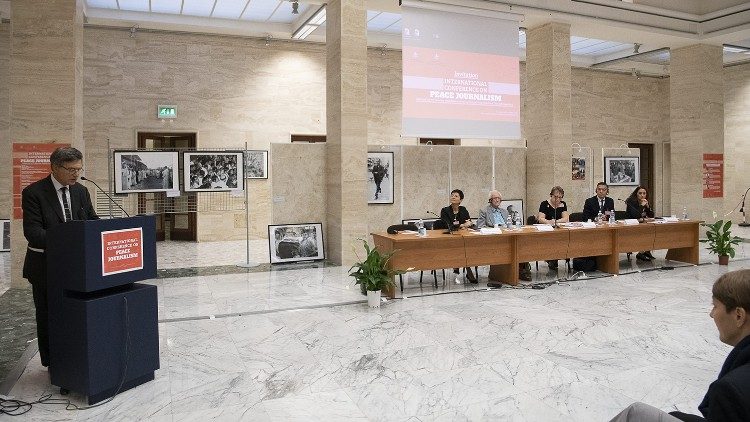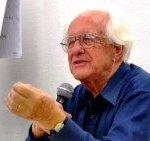Vatican Conference on Peace Journalism: Empathy, Not Only Sympathy
TRANSCEND News, NEWS, TMS PEACE JOURNALISM, TRANSCEND MEMBERS, MEDIA, RELIGION, 15 Oct 2018
Francesca Merlo – Vatican News
In a world in which bad news floods the media, the Vatican Dicastery for Communication holds a Conference on ‘Peace Journalism’, promoting this concept – along with the peace that comes with it.
13 Oct 2018 – Four peace journalists from Italy, Lebanon, China and Norway spoke today in an International Conference on “Peace Journalism”, held in and hosted by the Vatican.
Professor Johan Galtung, the creator of the concept, was one of these speakers. He defines Peace Journalism as “editors and reporters making choices – about what to report, and how to report it – that create opportunities for society at large to consider and to value nonviolent responses to conflict.”
Four peace journalists
Galtung highlighted the definition of peace, explaining that there is ‘violence’, – which is self-explanatory; ‘negative peace’, which implies a complete lack of interaction, either peaceful or violent, between two parties; and ‘positive peace’, which means interactions that involve “linking good to good”.
Rey-Sheng Her stressed the importance of ‘constructive journalism’. He explained that journalists must make a concise effort at solving problems and not simply “digging them out”.
Read also: ‘Peace Journalism’ to help build a more peaceful world – 8 May 2018
Stefania Tanesini spoke of ‘dialogic journalism’. This style, adopted within the focolari movement, describes the “concrete experience of hundreds of journalists”, who hope that their style will strengthen an empathetic and constructive dialogue whilst “constantly searching for peace”.
Vanessa Bassil was the fourth speaker. She is the founder of Media Association for Peace (MAP): the first non-governmental organisation in the Middle East, Northern Africa and Lebanon dedicated to fostering the role of media in building peace.
Peace when surrounded by conflict
She explained to Marine Henriot the need for Peace Journalism in the Middle East, an area of the world which is surrounded by conflict, in which people feel the crisis, “people are desperate, they are hopeless”, she said.
Bringing back hope
Vanessa believes that promoting a “constructive”, “hopeful” and “inspiring” journalism would bring back hope to the people. It would help them “deal with conflict in a more inspiring way, in a more constructive way”. “And thus”, she concluded, “we will have a society that is more safe, that is more secure and that is more peaceful.”
She also addressed the Syrian refugee crisis. Lebanon, with a population of 4 million, is currently hosting 2 million Syrian refugees fleeing conflict and hardship. “There is a lot of conflict between the host community and the refugees”, she said.
Positivity in negative situations
“We have decided to report positive stories about refugees”. By going out and meeting refugees living in camps, her and her colleagues tell “stories that give hope, that give inspiration”.
Vanessa uses the example of a lady they spoke to who fled Syria with her family. She told them about her “story of survival, of strength, of how she was able to do all of this alone.”
Empathy, not only sympathy
This, according to Vanessa Bassil, shows that they are not only “victims” but “independent people, capable of doing and of surviving”. And she chooses to transmit this through “empathy, and not only sympathy.”
Go to Original – vaticannews.va
DISCLAIMER: The statements, views and opinions expressed in pieces republished here are solely those of the authors and do not necessarily represent those of TMS. In accordance with title 17 U.S.C. section 107, this material is distributed without profit to those who have expressed a prior interest in receiving the included information for research and educational purposes. TMS has no affiliation whatsoever with the originator of this article nor is TMS endorsed or sponsored by the originator. “GO TO ORIGINAL” links are provided as a convenience to our readers and allow for verification of authenticity. However, as originating pages are often updated by their originating host sites, the versions posted may not match the versions our readers view when clicking the “GO TO ORIGINAL” links. This site contains copyrighted material the use of which has not always been specifically authorized by the copyright owner. We are making such material available in our efforts to advance understanding of environmental, political, human rights, economic, democracy, scientific, and social justice issues, etc. We believe this constitutes a ‘fair use’ of any such copyrighted material as provided for in section 107 of the US Copyright Law. In accordance with Title 17 U.S.C. Section 107, the material on this site is distributed without profit to those who have expressed a prior interest in receiving the included information for research and educational purposes. For more information go to: http://www.law.cornell.edu/uscode/17/107.shtml. If you wish to use copyrighted material from this site for purposes of your own that go beyond ‘fair use’, you must obtain permission from the copyright owner.
Read more
Click here to go to the current weekly digest or pick another article:
TRANSCEND News:
NEWS:
- Junta Continues Dropping Bombs after Myanmar Earthquake as Opposition Puts Down Arms
- Syria War Live News: Al-Assad in Russia; Search for Detainees at Sednaya Prison
- Leaked US Intelligence Documents Outline Israeli Preparations to Strike Iran
TMS PEACE JOURNALISM:
- Growing Up with Fear and Self-Awareness
- Transcending Mutually Assured Insanity
- A World’s Soul in Tatters
TRANSCEND MEMBERS:
- Problematic Global Secular Celebration of Passover?
- The American Psychological Association and the Weaponization of Antisemitism
- Have Militaristic ‘Culture,’ Enemy Images, and Threats of War Become the Unifying Force in Our Society?
MEDIA:
- The Media Navigator (2025)
- Zuckerberg and Musk Have Shown that Big Tech Doesn’t Care about Facts
- BBC Middle East Editor Collaborated with CIA, Mossad
RELIGION:

